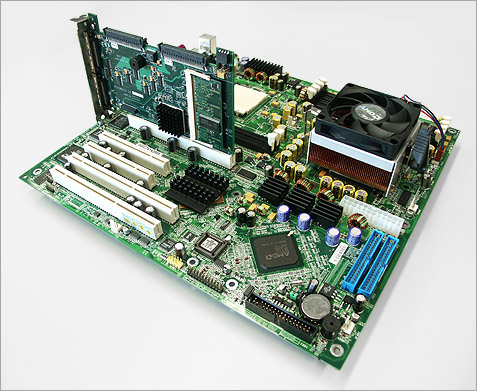The benchmarks where done on an MSI K8D Master dual Opteron board with two 32-bits 33MHz PCI-slots, three 100MHz PCI-X-slots (divided over two PCI-busses) and a 1.6GHz Opteron 242-processor. Testing was done using a Mylex AcceleRAID 600 and an LSI Logic MegaRAID Elite 1600. The Elite 1600 is an experienced dual channel Ultra160 SCSI-adapter that, in spite of his age of three years, still performs quite well. The adapter supports 64-bits 66MHz PCI and is based on a 100MHz Intel i960RN I/O processor. The Mylex AcceleRAID 600 is a modern dual channel Ultra320 SCSI-adapter which stands apart due to his high integration. The Xircon SCSI-controller and IBM PowerPC 405 I/O processor are all integrated into one chip, allowing for faster communication between these parts. Both cards where equipped with 128MB cache, the MegaRAID used 100MHz SDRAM and the AcceleRAID's flavor was 266MHz DDR SDRAM. The Mylex can set higher transfer rates than the MegaRAID due to its faster processor and memory, the latter is capable of a transfer rate of 136MB/s using write-back caching and adaptive read-ahead. Even though the MSI card is somewhat limited we felt it appropriate to use this card because of its good I/O performance, which is the most important.
The RAID-controllers where connected to four Maxtor Atlas 15k 18,4GB Ultra320 SCSI hard disks flying at 15.000 rotations per minute. These disks can achieve a maximum sequential transfer rate of 75MB/s.

MSI K8D Master mainboard and Mylex AcceleRAID 600 SCSI RAID adapter
To measure the influence of different PCI-bus speeds we tested the AcceleRAID 600 on a 100MHz PCI-X bus and on a PCI-X slot with a Promise FastTrak 100 connected to it, thus bringing the speed back to 66MHz.The MSI MegaRAID Elite 1600 was tested on a 64-bits 66MHz PCI-bus, a 32-bits 33MHz PCI-bus and a 32-bits 33MHz PCI-bus with some more load running in the background. The extra load was produced by an IOMeter transfer rate benchmark running on a Western Digital WD800JB hard disk which was connected to the Promise FastTrak. The FastTrak was placed next to the MegaRAID on the 32-bits 33MHz PCI-bus, thus generating a continuous bus-load of 25MB/s not counting overhead.
The performance of the above mentioned PCI and RAID configurations where measured using ATTO Disk Benchmark, Winbench '99 v2.0 and the StorageMark benchmarks developed in-house. These benchmarks where developed using Intel's IPEAK Storage Performance Toolkit and are based on access patterns resembling real world desktop and workstation applications. New in this review are the IPEAK SPT web- and database server benchmarks which will replace the IOMeter web server benchmarks. In hour opinion the access patterns created by IOMeter are tad to synthetic. This is why we created hour own benchmarks on a simulated Apache and MySQL server. The desktop benchmarks where done in RAID-0 and the server benchmarks in RAID-5, in both cases four disks where used.
